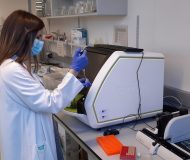

Researchers from the Research Institute of the Hospital de Sant Pau – IIB Sant Pan, the Hospital Clínic-IDIBAPS and the CIBERER, propose a biomarker that could accurately and non-invasively identify whether the origin of a psychotic outbreak is autoimmune or psychiatric. Their results, which have been published in Neurology, confirm for the first time that this marker is suitable to diagnose psychosis caused by autoimmune encephalitis and could have a major impact on clinical practice.
The reasons why someone may suffer a psychotic outbreak are diverse and knowing the origin of this outbreak in order to differentiate whether it is a psychiatric or autoimmune disease is key to propose the most appropriate treatment and monitoring of the disease. Currently, the diagnosis of autoimmune psychosis due to anti-NMDAR encephalitis is made by means of an antibody test that requires a spinal tap, which is not easy to obtain in psychiatric facilities and is not common in a first assessment.
In an article published in the journal Neurology, scientists from the Hospital de Sant Pau Research Institute – IIB Sant Pau, Hospital Clínic-IDIBAPS and the Centre for Biomedical Research Network on Rare Diseases (CIBERER), propose the use of a biomarker of neuronal damage in blood that will make it possible to identify accurately and non-invasively whether the origin of the psychotic break is autoimmune or psychiatric.
“Our study can have a major impact on clinical practice. We offer for the first time a non-invasive marker that allows us to identify those patients who are most at risk of NMDAR encephalitis, something that was not available until now,” explains Dr. Luis Querol, neurologist at the Hospital de Sant Pau and researcher in the Neuromuscular Diseases group of the Research Institute of the Hospital de Sant Pau – IIB Sant Pau and CIBERER.
“Having an immediate diagnosis thanks to this marker allows us to propose the most appropriate treatment and to know when it is necessary to do more tests or monitor the progress of the disease,” adds Lorena Martín, researcher in the same group and one of the first authors of the article.
Most patients arriving with a first episode of psychosis require antipsychotic drugs, which in turn can trigger adverse neurological events indistinguishable from anti-NMDAR encephalitis. Treating them without a diagnosis of the origin of psychosis makes differential diagnosis very difficult because new symptoms may be attributed to a neuroleptic-induced complication in a psychiatric patient when it could possibly be an evolving autoimmune encephalitis. Also, delaying therapeutic interventions while waiting for antibody results would not be a valid option, as early treatment is an important factor in the prognosis of these patients.
The biomarker proposed by the researchers is NfL (Neurofilament light chain) protein. Levels of this protein in the blood indicate neuronal damage and this makes it a good marker for diagnosing and assessing progression or treatment in many neurological diseases, such as multiple sclerosis, dementia or neuropathy. The main benefit is that it can be obtained with a blood test and thus avoid more invasive diagnostic techniques, such as spinal tap.
The paper shows that young patients with a first psychotic outbreak and NfL levels above 15 pg/ml are 120 times more likely to have NMDAR encephalitis than a psychiatric outbreak. Therefore, blood NfL levels can accurately determine which patients with a first psychotic outbreak need further neurological assessment and spinal tap.
“Until now, this biomarker has not been proposed for the diagnosis of autoimmune encephalitis, and only a few studies have evaluated it in relation to the prognosis and severity of the disease,” says Mar Guasp, a pre-doctoral researcher at Hospital Clínic-IDIBAPS and one of the first authors of the study.
“Our results show not only that it is an excellent candidate for a first diagnosis and screening, but also that it could be a good marker to obtain better results in the long-term monitoring of patients when they leave the ICU or are discharged from hospital,” adds Dr. Josep Dalmau, at Hospital Clínic-IDIBAPS and CIBERER.
First authors of this paper are researchers Lorena Martín Aguilar, from the Research Institute of the Hospital de Sant Pau – IIB Sant Pau, and Mar Guasp, from the Clínic-IDIBAPS as first authors. They counted with the participation of other members at both institutions led by Dr. Luis Querol and Dr. Josep Dalmau. The study has been supported and funded by Instituto de Salud Carlos III (ISCIII), ERA-NET Neuron, CIBERER, “la Caixa” Foundation, Edmond J. Safra Foundation, Cellex Foundation, Torrons Vicens Foundation, and the strategic plan for research and innovation in health (PERIS) of the Generalitat de Catalunya.
Reference article
Mar Guasp, Lorena Martín-Aguilar, Lidia Sabater, et al. Neurofilament Light Chain Levels in Anti-NMDAR Encephalitis and Primary Psychiatric Psychosis. Neurology. February 10, 2022. DOI: https://doi.org/10.1212/WNL.0000000000200021